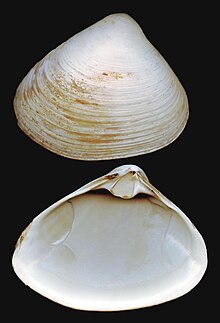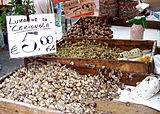
Shellfish, in colloquial and fisheries usage, are exoskeleton-bearing aquatic invertebrates used as food, including various species of molluscs, crustaceans, and echinoderms. Although most kinds of shellfish are harvested from saltwater environments, some are found in freshwater. In addition, a few species of land crabs are eaten, for example Cardisoma guanhumi in the Caribbean. Shellfish are among the most common food allergens.
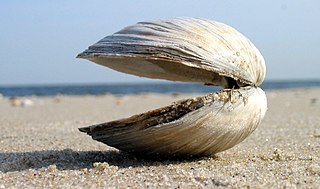
Clam is a common name for several kinds of bivalve mollusc. The word is often applied only to those that are edible and live as infauna, spending most of their lives halfway buried in the sand of the sea floor or riverbeds. Clams have two shells of equal size connected by two adductor muscles and have a powerful burrowing foot. They live in both freshwater and marine environments; in salt water they prefer to burrow down into the mud and the turbidity of the water required varies with species and location; the greatest diversity of these is in North America.

Clam digging is a North American term for a common way to harvest clams from below the surface of the tidal sand flats or mud flats where they live. It is done both recreationally and commercially. Commercial digging in the U.S. and Canada is colloquially referred to as clamming, and is done by a clammer.

The American oystercatcher, occasionally called the American pied oystercatcher, is a member of family Haematopodidae. Originally called the "sea pie", it was renamed in 1731 when naturalist Mark Catesby claimed that he had observed the bird eating oysters. The current population of American oystercatchers is estimated to be 43,000. There are estimated to be 1,500 breeding pairs along the Atlantic and Gulf Coasts of the US. The bird is marked by its black and white body and a long, thick orange beak.

The Pacific razor clam, Siliqua patula, is a species of large marine bivalve mollusc in the family Pharidae.
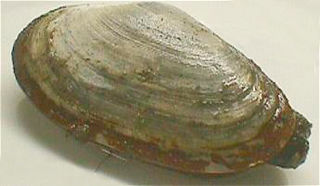
Soft-shell clams or Sand gaper, scientific name Mya arenaria, popularly called "steamers", "softshells", "piss clams", "Ipswich clams", or "Essex clams", are a species of edible saltwater clam, a marine bivalve mollusk in the family Myidae.

The hard clam, also known as the round clam, hard-shellclam, or the quahog, is an edible marine bivalve mollusk that is native to the eastern shores of North America and Central America from Prince Edward Island to the Yucatán Peninsula. It is one of many unrelated edible bivalves that in the United States are frequently referred to simply as clams. Older literature sources may use the systematic name Venus mercenaria; this species is in the family Veneridae, the venus clams.

Callista chione, the smooth clam, is a rather large, temperate, marine, bivalve mollusc that inhabits sandy bottoms or with small pebbles in clean waters down to about 200 m from the British Isles to the Mediterranean. The shell can reach up to about 110 mm Ø, its outer side is smooth and ranges from light greenish creamy colour to medium brown, probably varies to match the background; the interior is white to soft pink. The concentric and radial growth lines are easily seen. Callista chione is edible, different dishes are prepared throughout the Mediterranean in Spain, Italy, France, the Balkan and the Maghreb countries.

Ark clam is the common name for a family of small to large-sized saltwater clams or marine bivalve molluscs in the family Arcidae. Generally less than 80 mm long, ark clams vary both in shape and size. They number about 200 species worldwide.

The Atlantic jackknife clam, Ensis leei, also known as the bamboo clam, American jackknife clam or razor clam, is a large edible marine bivalve mollusc found on the North American Atlantic coast, from Canada to South Carolina. The species was also introduced to Europe at the end of the 70's and is already extremely abundant there in suitable habitats. The name "razor clam" is also used to refer to different species such as the Pacific razor clam or Razor shell.
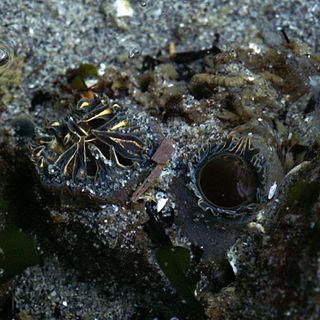
Tresus capax is a species of saltwater clam, marine bivalve mollusk, common name the fat gaper, in the family Mactridae. It also shares the common name horse clam with Tresus nuttallii a species which is similar in morphology and lifestyle. Both species are somewhat similar to the geoduck, though smaller, with shells up to eight inches long (20 cm), weight to 3–4 lb (1.4–1.8 kg).
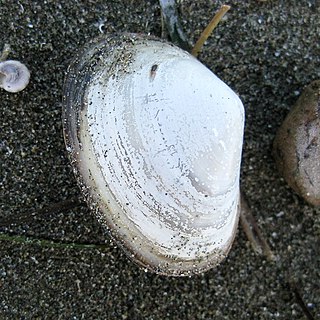
Paphies australis or pipi is a bivalve mollusc of the family Mesodesmatidae, endemic to New Zealand.
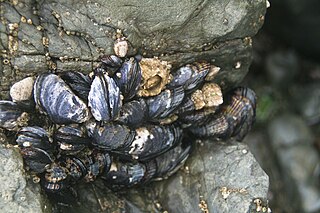
The California mussel is a large edible mussel, a marine bivalve mollusk in the family Mytilidae.
The pod razor is a coastal bivalve of European waters. It is edible and has been fished commercially, especially in Portugal, Spain, Ireland and Scotland.

The ocean quahog is a species of edible clam, a marine bivalve mollusk in the family Arcticidae. This species is native to the North Atlantic Ocean, and it is harvested commercially as a food source. This species is also known by a number of different common names, including Icelandic cyprine, mahogany clam, mahogany quahog, black quahog, and black clam.

Spisula is a genus of medium-sized to large marine bivalve mollusks or clams in the subfamily Mactrinae of the family Mactridae, commonly known as surf clams or trough shells.

Mya truncata, common name the blunt gaper or truncate softshell, is a species of edible saltwater clam, a marine bivalve mollusk in the family Myidae.

Tresus nuttallii, common name the Pacific gaper, is a species of saltwater clam, a marine bivalve mollusk in the family Mactridae. It also shares the common name horse clam with Tresus capax, a species which is similar in morphology and lifestyle. Both species are somewhat similar to the Geoduck, though smaller, with shells up to eight inches long (20 cm), weight to 3–4 lb (1.4–1.8 kg).

Megapitaria squalida, the chocolate clam, is a species of bivalve mollusc in the family Veneridae. It was first described to science by George Brettingham Sowerby, a British conchologist, in 1835. The type specimen was collected by Hugh Cuming.
